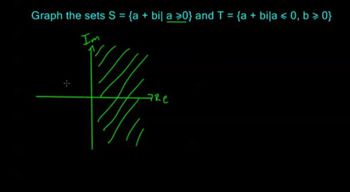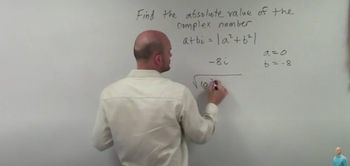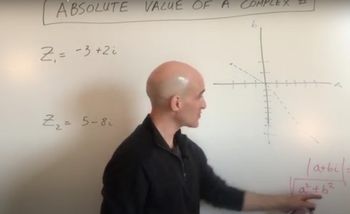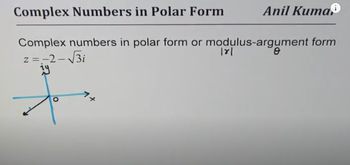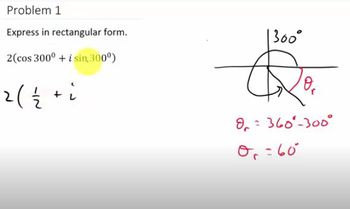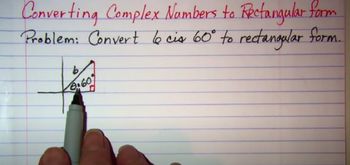Table of contents
- 0. Review of College Algebra4h 43m
- 1. Measuring Angles39m
- 2. Trigonometric Functions on Right Triangles2h 5m
- 3. Unit Circle1h 19m
- 4. Graphing Trigonometric Functions1h 19m
- 5. Inverse Trigonometric Functions and Basic Trigonometric Equations1h 41m
- 6. Trigonometric Identities and More Equations2h 34m
- 7. Non-Right Triangles1h 38m
- 8. Vectors2h 25m
- 9. Polar Equations2h 5m
- 10. Parametric Equations1h 6m
- 11. Graphing Complex Numbers1h 7m
11. Graphing Complex Numbers
Polar Form of Complex Numbers
Problem 19
Textbook Question
In Exercises 11–26, plot each complex number. Then write the complex number in polar form. You may express the argument in degrees or radians. −3
 Verified step by step guidance
Verified step by step guidance1
Step 1: Identify the complex number. In this case, the complex number is \(-3\), which can be written as \(-3 + 0i\).
Step 2: Plot the complex number on the complex plane. The real part is \(-3\) and the imaginary part is \(0\), so the point is located on the real axis at \(-3\).
Step 3: Determine the modulus (magnitude) of the complex number using the formula \(|z| = \sqrt{a^2 + b^2}\), where \(a\) is the real part and \(b\) is the imaginary part.
Step 4: Calculate the argument (angle) of the complex number. Since the number is on the negative real axis, the argument is \(\pi\) radians or \(180^\circ\).
Step 5: Write the complex number in polar form using the formula \(z = r(\cos \theta + i\sin \theta)\), where \(r\) is the modulus and \(\theta\) is the argument.
Recommended similar problem, with video answer:
 Verified Solution
Verified SolutionThis video solution was recommended by our tutors as helpful for the problem above
Video duration:
3mPlay a video:
Was this helpful?
Key Concepts
Here are the essential concepts you must grasp in order to answer the question correctly.
Complex Numbers
Complex numbers are numbers that have a real part and an imaginary part, expressed in the form a + bi, where 'a' is the real part and 'b' is the imaginary part. In this context, the complex number -3 can be represented as -3 + 0i, indicating that it lies on the real axis of the complex plane.
Recommended video:

Dividing Complex Numbers
Polar Form of Complex Numbers
The polar form of a complex number expresses it in terms of its magnitude (or modulus) and angle (or argument). It is represented as r(cos θ + i sin θ) or r e^(iθ), where r is the distance from the origin to the point in the complex plane, and θ is the angle formed with the positive real axis. For -3, the polar form can be calculated using its modulus and argument.
Recommended video:

Complex Numbers In Polar Form
Magnitude and Argument
The magnitude of a complex number is the distance from the origin to the point in the complex plane, calculated using the formula r = √(a² + b²). The argument is the angle formed with the positive real axis, which can be found using the arctangent function. For the complex number -3, the magnitude is 3, and the argument is π radians (or 180 degrees), as it lies on the negative real axis.
Recommended video:

Finding Magnitude of a Vector

 4:47m
4:47mWatch next
Master Complex Numbers In Polar Form with a bite sized video explanation from Nick Kaneko
Start learningRelated Videos
Related Practice




